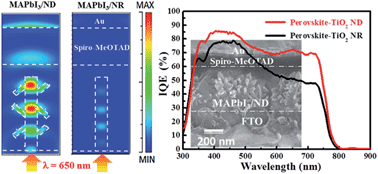Nanophotonic perovskite solar cell architecture with a three-dimensional TiO2 nanodendrite scaffold for light trapping and electron collection†
Abstract
Nanophotonic perovskite solar cells have been fabricated by infiltrating methylammonium lead iodide (MAPbI3) into the interstices of the quasi-single-crystalline TiO2 nanodendrite (ND) array. The TiO2 ND array in the active layer serves as not only the nanophotonic light trapping structure but also the electron transport medium for enhancing both light harvesting and electron collection to challenge the issue of short electron diffusion length in MAPbI3-based solar cells. Finite difference time domain simulation results indicate that the ND in the MAPbI3 matrix exhibits superior light trapping performance compared to the nanorod (NR), which can well explain the comparable light harvesting in the MAPbI3–TiO2 ND and the MAPbI3–TiO2 NR solar cells although the MAPbI3 amount in the former is ∼10% less. Moreover, the branches developed from the trunks of the NDs will extract the photoelectrons from MAPbI3 to reduce the electron transport length in the MAPbI3 matrix. The higher internal quantum efficiencies, especially at longer wavelengths, confirm the enhanced electron collection in the MAPbI3–TiO2 ND solar cell. Compared to the MAPbI3–TiO2 NR solar cell, the 22% and 25% enhancements in the average Jsc and PCE are respectively attained in the MAPbI3–TiO2 ND solar cells.


 Please wait while we load your content...
Please wait while we load your content...